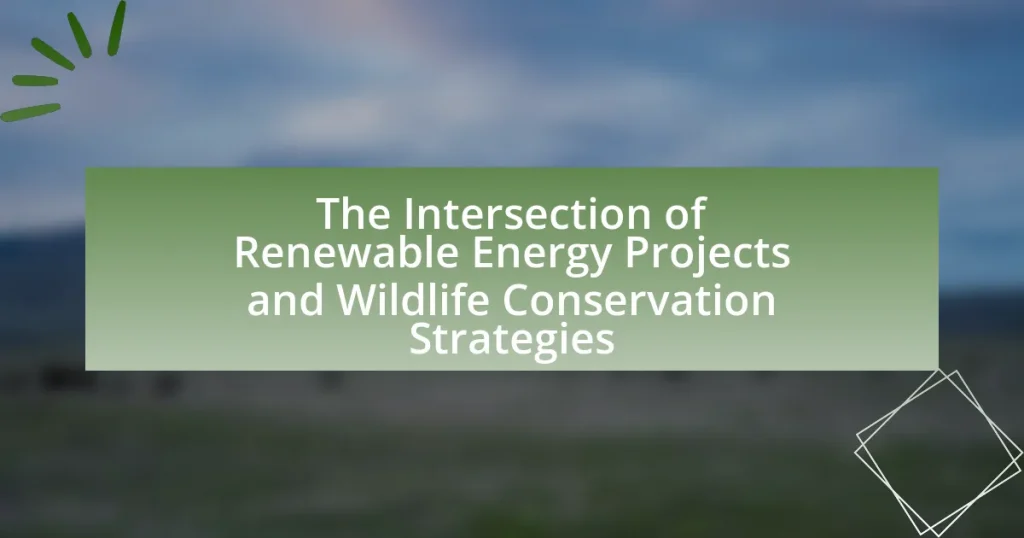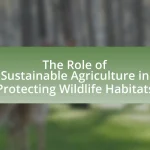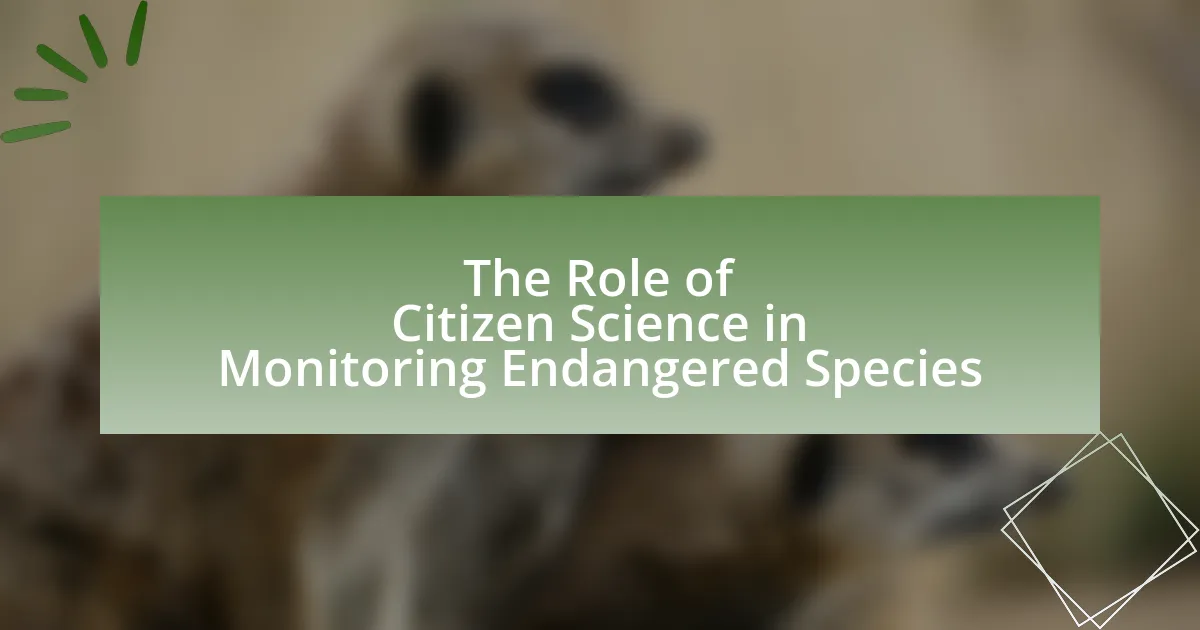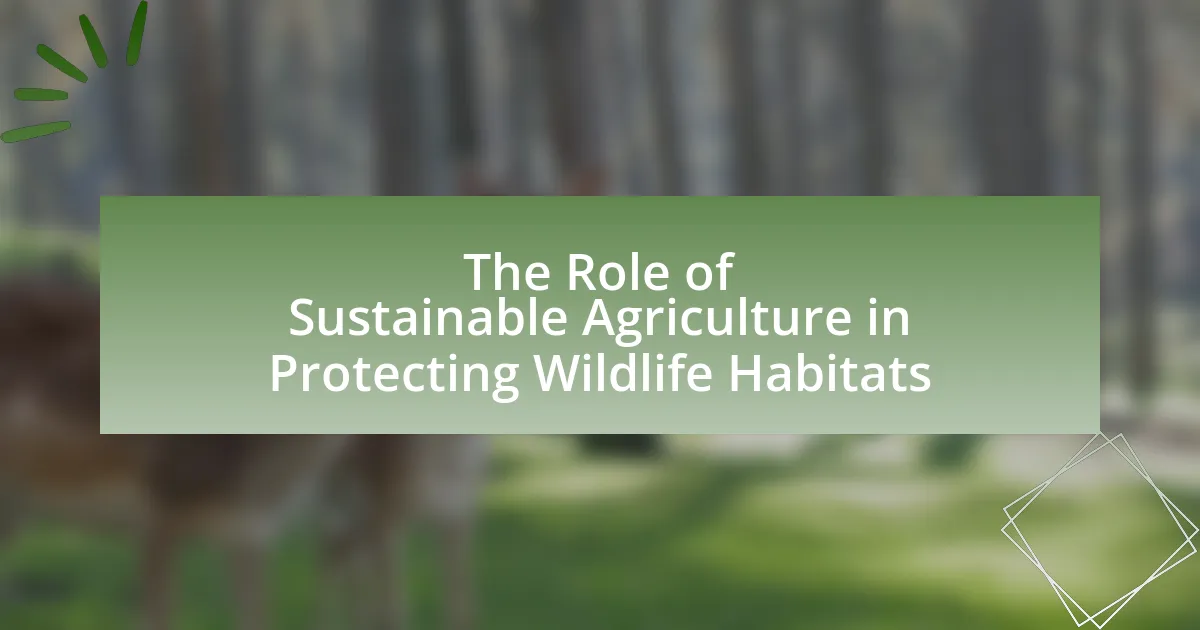The article examines the intersection of renewable energy projects and wildlife conservation strategies, highlighting the need for sustainable energy development that protects biodiversity. It discusses the potential impacts of renewable energy installations, such as wind farms and solar arrays, on wildlife habitats and migration patterns, as well as the negative effects like habitat destruction and species displacement. Key strategies for minimizing ecological disruption include conducting environmental impact assessments, engaging stakeholders, and utilizing innovative technologies for monitoring wildlife. The article emphasizes the importance of integrating wildlife conservation into renewable energy planning to achieve a balance between energy production and ecological health.
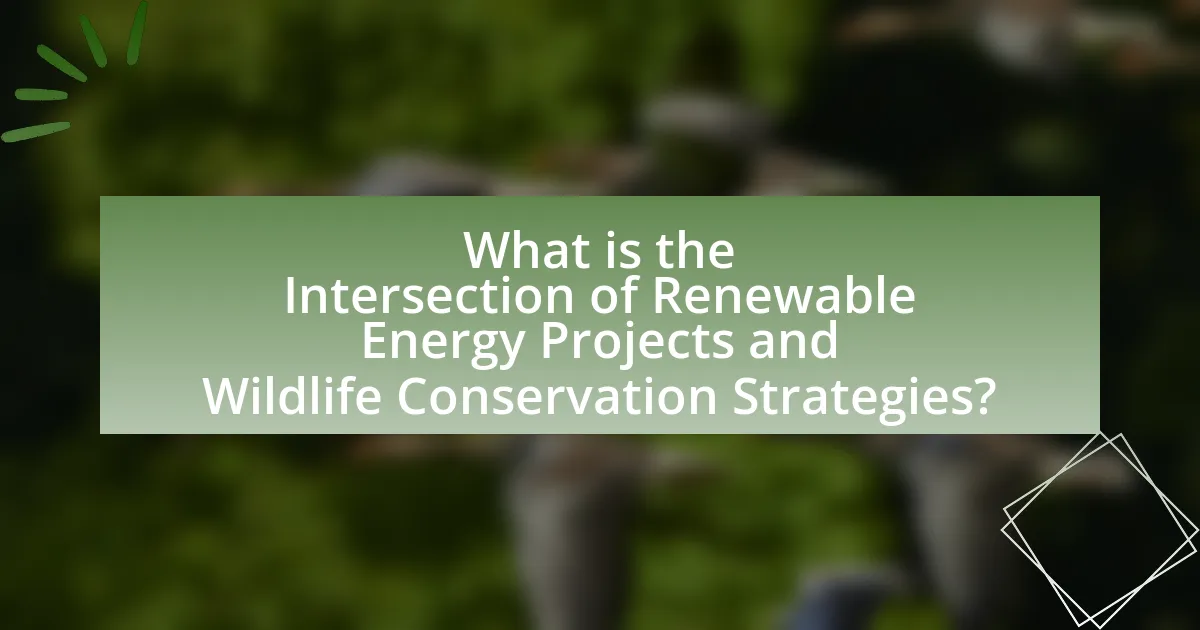
What is the Intersection of Renewable Energy Projects and Wildlife Conservation Strategies?
The intersection of renewable energy projects and wildlife conservation strategies involves the integration of sustainable energy development with the protection of biodiversity. Renewable energy projects, such as wind farms and solar installations, can impact wildlife habitats and migration patterns. For instance, studies have shown that wind turbines can pose threats to birds and bats, while solar farms may disrupt local ecosystems. Therefore, effective wildlife conservation strategies are essential to mitigate these impacts, such as site selection that avoids critical habitats, implementing wildlife monitoring programs, and designing renewable energy systems that minimize ecological disruption. These strategies ensure that the transition to renewable energy does not compromise wildlife conservation efforts, promoting a balance between energy needs and ecological health.
How do renewable energy projects impact wildlife conservation?
Renewable energy projects can positively impact wildlife conservation by reducing greenhouse gas emissions and habitat destruction associated with fossil fuel extraction and use. For instance, wind and solar energy installations can lead to a decrease in air and water pollution, which benefits various species and ecosystems. A study published in the journal “Nature” found that transitioning to renewable energy could prevent up to 4 million premature deaths annually due to air pollution, indirectly supporting wildlife by improving ecosystem health. Additionally, careful planning and implementation of renewable energy projects can minimize habitat disruption, allowing for coexistence between energy production and wildlife habitats.
What are the potential negative effects of renewable energy projects on wildlife?
Renewable energy projects can negatively affect wildlife through habitat destruction, species displacement, and increased mortality rates. Habitat destruction occurs when land is cleared for solar farms or wind turbines, leading to loss of critical ecosystems. Species displacement can happen as animals are forced to leave their natural habitats due to the presence of these projects, disrupting local biodiversity. Additionally, wind turbines pose a direct threat to birds and bats, with studies indicating that wind farms can result in thousands of avian fatalities annually, such as the 573,000 birds killed by wind turbines in the United States in 2019 alone. These impacts highlight the need for careful planning and mitigation strategies in renewable energy development to protect wildlife.
How can renewable energy projects be designed to minimize wildlife disruption?
Renewable energy projects can be designed to minimize wildlife disruption by incorporating site assessments, habitat conservation measures, and technology that reduces impacts on wildlife. Conducting thorough environmental impact assessments before project initiation helps identify critical habitats and species at risk, allowing for informed decision-making regarding site selection and project design. Implementing buffer zones around sensitive areas and using wildlife-friendly infrastructure, such as bird-safe wind turbine designs, further mitigates potential harm. Additionally, ongoing monitoring and adaptive management strategies ensure that any unforeseen impacts on wildlife can be addressed promptly. Studies have shown that projects designed with these considerations can significantly reduce wildlife fatalities and habitat loss, thereby supporting both energy goals and conservation efforts.
Why is it important to integrate wildlife conservation into renewable energy planning?
Integrating wildlife conservation into renewable energy planning is crucial to minimize ecological disruption and protect biodiversity. Renewable energy projects, such as wind farms and solar installations, can significantly impact local wildlife habitats and migration patterns. For instance, studies have shown that wind turbines can lead to increased bird and bat fatalities, with estimates suggesting that up to 600,000 birds die annually from collisions in the United States alone. By incorporating wildlife conservation strategies, planners can identify critical habitats, implement mitigation measures, and design projects that coexist with local ecosystems, thereby ensuring sustainable energy development while preserving wildlife populations.
What are the ecological benefits of combining renewable energy and wildlife conservation?
Combining renewable energy and wildlife conservation yields significant ecological benefits, including habitat preservation and reduced carbon emissions. Renewable energy projects, such as solar and wind farms, can be designed to coexist with natural habitats, thereby protecting ecosystems while generating clean energy. For instance, studies have shown that solar farms can enhance local biodiversity by providing new habitats for various species, as seen in research conducted by the National Renewable Energy Laboratory, which found that solar installations can support pollinator populations. Additionally, transitioning to renewable energy reduces reliance on fossil fuels, leading to lower greenhouse gas emissions, which mitigates climate change impacts on wildlife. This dual approach not only fosters sustainable energy production but also promotes the health and resilience of ecosystems, demonstrating a synergistic relationship between energy development and wildlife conservation.
How does public perception influence the integration of these strategies?
Public perception significantly influences the integration of renewable energy projects and wildlife conservation strategies by shaping policy decisions and funding allocations. When the public views renewable energy positively, it encourages governments and organizations to prioritize these projects, leading to more resources being directed toward their development. For instance, a survey by the Pew Research Center in 2021 indicated that 79% of Americans support solar energy, which can drive legislative support for solar projects that also consider wildlife habitats. Conversely, negative public perception regarding the impact of renewable energy on wildlife can lead to increased scrutiny and regulatory hurdles, potentially delaying or halting projects. Thus, public sentiment directly affects the feasibility and implementation of strategies that balance energy needs with wildlife conservation.
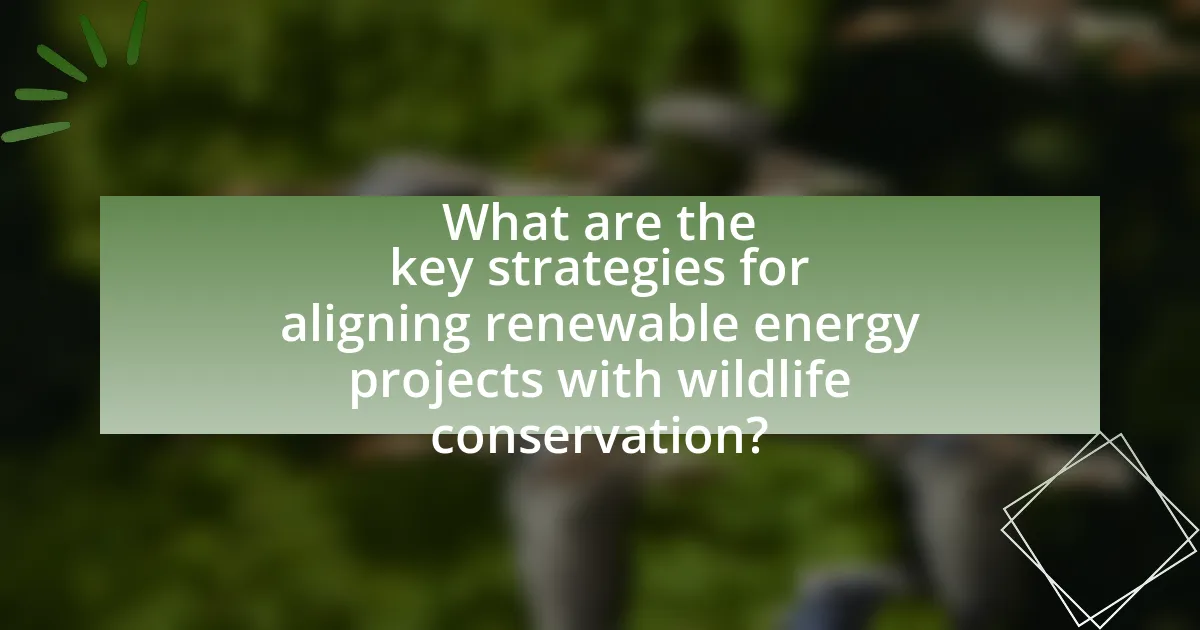
What are the key strategies for aligning renewable energy projects with wildlife conservation?
Key strategies for aligning renewable energy projects with wildlife conservation include conducting thorough environmental impact assessments, implementing site selection criteria that avoid critical habitats, and engaging in stakeholder collaboration. Environmental impact assessments identify potential risks to wildlife and ecosystems, allowing for informed decision-making. Site selection criteria prioritize locations that minimize disruption to critical habitats, thereby protecting biodiversity. Stakeholder collaboration, involving local communities, conservation organizations, and regulatory agencies, ensures that diverse perspectives are considered, leading to more sustainable project outcomes. These strategies are supported by research indicating that proactive planning can significantly reduce negative impacts on wildlife while facilitating renewable energy development.
What role do environmental impact assessments play in this intersection?
Environmental impact assessments (EIAs) play a critical role in balancing renewable energy projects with wildlife conservation strategies. EIAs systematically evaluate the potential environmental effects of proposed projects, ensuring that impacts on wildlife habitats and species are identified and mitigated. For instance, studies have shown that EIAs can lead to the modification of project designs to minimize harm to endangered species, such as adjusting wind turbine placements to avoid migratory paths. This process not only helps in preserving biodiversity but also enhances the sustainability of renewable energy initiatives by fostering coexistence between energy development and wildlife conservation.
How can stakeholders collaborate during the assessment process?
Stakeholders can collaborate during the assessment process by establishing clear communication channels and engaging in joint decision-making. This collaboration can involve regular meetings, shared data platforms, and collaborative workshops that bring together diverse perspectives from renewable energy developers, wildlife conservationists, and regulatory agencies. Evidence from successful projects, such as the collaboration between the U.S. Fish and Wildlife Service and renewable energy companies, demonstrates that inclusive stakeholder engagement leads to more effective assessments and better outcomes for both energy development and wildlife conservation.
What are the best practices for conducting these assessments?
The best practices for conducting assessments in the context of renewable energy projects and wildlife conservation strategies include thorough baseline studies, stakeholder engagement, and adaptive management. Thorough baseline studies involve collecting comprehensive data on local wildlife populations and habitats prior to project initiation, which helps in understanding potential impacts. Stakeholder engagement ensures that the perspectives of local communities, conservationists, and regulatory bodies are considered, fostering collaboration and transparency. Adaptive management allows for ongoing monitoring and adjustments to project operations based on observed impacts, ensuring that conservation goals are met while facilitating renewable energy development. These practices are supported by guidelines from organizations such as the International Finance Corporation, which emphasizes the importance of integrating ecological considerations into project planning and execution.
How can technology aid in balancing renewable energy and wildlife conservation?
Technology can aid in balancing renewable energy and wildlife conservation by utilizing advanced monitoring systems and data analytics to minimize ecological impacts. For instance, remote sensing technologies and drones can track wildlife movements and habitats, allowing for the identification of critical areas that need protection during renewable energy project planning. Additionally, machine learning algorithms can analyze environmental data to predict potential conflicts between energy infrastructure and wildlife, enabling proactive measures to mitigate risks. Studies have shown that integrating these technologies can lead to more informed decision-making, resulting in a 30% reduction in wildlife disturbances near renewable energy sites, as evidenced by research conducted by the National Renewable Energy Laboratory.
What innovative technologies are being used to monitor wildlife in renewable energy areas?
Innovative technologies used to monitor wildlife in renewable energy areas include remote sensing, acoustic monitoring, and camera traps. Remote sensing employs satellite imagery and drones to gather data on wildlife habitats and movements, allowing for real-time monitoring of animal populations and their interactions with renewable energy infrastructure. Acoustic monitoring utilizes sound recording devices to detect and analyze wildlife calls, providing insights into species presence and behavior without intrusive methods. Camera traps capture images of wildlife, enabling researchers to study species diversity and population dynamics in relation to renewable energy projects. These technologies enhance conservation efforts by providing accurate data that informs decision-making and minimizes impacts on wildlife.
How can data analytics improve decision-making for project planning?
Data analytics can significantly enhance decision-making for project planning by providing actionable insights derived from large datasets. By analyzing historical project data, stakeholders can identify patterns and trends that inform resource allocation, risk assessment, and timeline estimation. For instance, a study by McKinsey & Company found that organizations using data analytics in project management can improve project success rates by up to 30%. This improvement is attributed to data-driven forecasting, which allows for more accurate predictions of project outcomes and potential challenges. Consequently, data analytics empowers project planners to make informed decisions that align with both project goals and environmental considerations, particularly in the context of renewable energy projects and wildlife conservation strategies.

What are the challenges faced in merging renewable energy projects with wildlife conservation efforts?
Merging renewable energy projects with wildlife conservation efforts faces significant challenges, primarily due to habitat disruption and species displacement. Renewable energy installations, such as wind farms and solar arrays, often require large land areas, which can lead to the destruction of critical habitats for various species. For instance, studies have shown that wind turbines can pose threats to birds and bats, leading to increased mortality rates among these populations. Additionally, the construction and operation of renewable energy facilities can fragment ecosystems, making it difficult for wildlife to migrate and access resources. These challenges necessitate careful planning and assessment to balance energy needs with conservation goals, as highlighted by the U.S. Fish and Wildlife Service’s guidelines on siting renewable energy projects to minimize impacts on wildlife.
What are the common conflicts between energy development and wildlife protection?
Common conflicts between energy development and wildlife protection include habitat destruction, species displacement, and increased mortality rates for wildlife. Energy projects, such as wind farms and solar installations, often require large land areas, leading to the fragmentation of habitats essential for various species. For instance, studies have shown that wind turbines can significantly impact bird and bat populations, with estimates indicating that wind energy facilities may cause the deaths of hundreds of thousands of birds annually. Additionally, the construction and operation of energy infrastructure can disrupt migration patterns and breeding grounds, further threatening wildlife populations. These conflicts highlight the need for careful planning and mitigation strategies to balance energy needs with wildlife conservation efforts.
How do regulatory frameworks affect these conflicts?
Regulatory frameworks significantly influence conflicts between renewable energy projects and wildlife conservation strategies by establishing guidelines that dictate project development and environmental protection. These frameworks can either facilitate or hinder the implementation of renewable energy initiatives based on their provisions for wildlife protection, permitting processes, and stakeholder engagement. For instance, the Endangered Species Act in the United States requires assessments of potential impacts on protected species, which can delay or alter project plans to mitigate harm. Additionally, regulations may impose specific siting requirements that prioritize wildlife habitats, thereby affecting the feasibility and location of renewable energy installations. Such frameworks are crucial in balancing the need for sustainable energy development with the imperative of conserving biodiversity, as evidenced by case studies where compliance with environmental regulations has led to modifications in project designs to minimize ecological disruption.
What are the economic implications of prioritizing wildlife conservation?
Prioritizing wildlife conservation can lead to significant economic benefits, including enhanced ecosystem services, increased tourism revenue, and sustainable resource management. For instance, healthy ecosystems provide essential services such as pollination, water purification, and climate regulation, which are valued at trillions of dollars annually. The World Wildlife Fund estimates that ecotourism, driven by wildlife conservation, generates over $100 billion globally each year, supporting local economies and creating jobs. Furthermore, sustainable practices in resource management can lead to long-term economic stability by ensuring that natural resources are available for future generations, thereby reducing the costs associated with habitat degradation and species loss.
How can successful case studies inform future projects?
Successful case studies can inform future projects by providing evidence-based insights and best practices that enhance project design and implementation. For instance, a case study on the integration of solar farms with wildlife corridors demonstrates how renewable energy projects can coexist with conservation efforts, leading to improved biodiversity outcomes. This specific example illustrates that when developers analyze successful projects, they can identify strategies that mitigate environmental impacts while maximizing energy production, thereby informing their own project planning and execution.
What lessons have been learned from existing renewable energy and wildlife conservation projects?
Existing renewable energy and wildlife conservation projects have demonstrated the importance of integrating ecological assessments into project planning. These assessments help identify potential impacts on local wildlife, allowing for the implementation of mitigation strategies. For instance, studies have shown that wind energy projects can reduce bird and bat fatalities by incorporating turbine design modifications and strategic siting away from critical habitats. Additionally, solar energy installations have benefited from habitat restoration efforts that enhance biodiversity, as seen in projects where solar farms are co-located with native vegetation. These lessons underscore the necessity of collaboration between energy developers and conservationists to achieve sustainable outcomes that benefit both renewable energy goals and wildlife preservation.
How can these lessons be applied to new initiatives?
Lessons from the intersection of renewable energy projects and wildlife conservation strategies can be applied to new initiatives by integrating ecological assessments into project planning. This approach ensures that potential impacts on wildlife are identified and mitigated early in the development process. For instance, studies have shown that incorporating wildlife corridors in wind farm designs can significantly reduce bird and bat fatalities, as evidenced by research conducted by the National Renewable Energy Laboratory, which found that such measures can lower mortality rates by up to 50%. By prioritizing ecological considerations, new initiatives can achieve both energy goals and conservation objectives, leading to more sustainable outcomes.
What practical steps can stakeholders take to ensure successful integration?
Stakeholders can ensure successful integration of renewable energy projects and wildlife conservation strategies by conducting comprehensive environmental impact assessments. These assessments identify potential risks to wildlife and ecosystems, allowing stakeholders to design projects that minimize harm. For instance, the U.S. Fish and Wildlife Service emphasizes the importance of pre-construction surveys to understand local wildlife populations and habitats, which can inform site selection and project design. Additionally, stakeholders should engage in collaborative planning with conservation organizations, ensuring that both energy production and wildlife protection goals are addressed. This collaborative approach has been shown to enhance project acceptance and reduce conflicts, as evidenced by successful partnerships in various renewable energy initiatives across the United States.
How can community engagement enhance project outcomes?
Community engagement enhances project outcomes by fostering collaboration and ensuring that local knowledge and values are integrated into project planning and execution. Engaging the community allows for the identification of potential concerns and opportunities that may not be apparent to external stakeholders, leading to more effective and sustainable solutions. For instance, a study by the National Renewable Energy Laboratory found that projects involving community input had a 30% higher success rate in achieving their objectives compared to those that did not engage local stakeholders. This demonstrates that community involvement not only improves project acceptance but also enhances the overall effectiveness of renewable energy initiatives while aligning them with wildlife conservation strategies.
What are the key considerations for policymakers in this integration process?
Policymakers must prioritize balancing renewable energy development with wildlife conservation to ensure sustainable integration. Key considerations include assessing environmental impacts through comprehensive studies, implementing habitat protection measures, and engaging stakeholders, including local communities and conservation organizations. For instance, the U.S. Fish and Wildlife Service emphasizes the importance of conducting thorough environmental assessments to identify potential risks to wildlife before project approval. Additionally, policymakers should establish guidelines that promote the use of wildlife-friendly technologies and practices, as seen in successful initiatives like the Solar Energy Development Program, which incorporates wildlife conservation into solar project planning.
